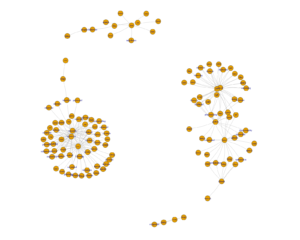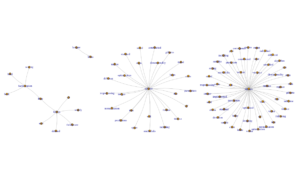Summary: XGBoost and ensembles take the Kaggle cake but they’re mainly used for classification tasks. Some tools like factorization machines and vowpal wabbit make occasional appearances.
Algorithm Frequency
An important question we can ask this data set is “What tools” are being used. And we can answer this question, better than my original anecdote driven method.
In the table below, I list the term I searched for, the frequency of that term being referenced, the number of competitions it is referenced by, and then the type of competition it was used in. I broke the 33 competitions into classification (21 competitions), ranking (5), and numeric prediction (7) tasks.
term freq comps class_comps rank_comps numeric_comps
xgboost 76 16 11 3 2
ensemble 44 8 5 2 1
gbm 23 8 2 2 4
knn 20 6 4 0 2
neural 19 7 5 0 2
regression 18 8 2 1 5
ffm 16 3 3 0 0
svd 16 2 1 1 0
boosting 14 9 4 2 3
forest 10 7 3 1 3
factorization 8 4 2 1 1
logistic 7 6 6 0 0
pca 7 2 2 0 0
svm 7 3 3 0 0
adaboost 6 4 4 0 0
lasso 6 2 1 1 0
clustering 5 4 2 1 1
ridge 4 3 1 1 1
libffm 3 2 1 1 0
vowpal 3 3 2 0 1
libfm 2 2 2 0 0
I used the tm package from R which does not use ngrams. As a result, I had to use terms like “forest” instead of “random forest”. So there may be some cross contamination but there’s still good directional material here.
Ultimately, xgboost and ensembles are the most important tools in a Kaggler’s toolbox. However, it’s mostly due to the classification tasks that are most common on Kaggle.
Another important set of tools are factorization models. That includes libfm, libffm, and ffm. They appear in six different competitions (4 classifications, 1 ranking, and 1 numeric).
Important Associations

See the relationships between algorithms and related terms (r = 0.90). Caution: Linked to a big png.
With all this data, I was able to visualize the relationships between some of the algorithms and the terms that were being used. (Hat Tip to Katya Ognyanova for her network visualization in R tutorial).
This is a lot of data, so I kept it only to highly correlated terms (r = 0.90) which cuts out some of the interactions between algorithms. At the very least, the plot above shows a few relationships between PCA and Neural Networks, Lasso Regression and Keras (which is a little surprising), and SVD + Ensembles + Regression all seem to mingle together in the bottom left corner.
To dig a little deeper, I blew out the three sets of algorithms / tools: factorization machines, xgboost, and SKLearn.
If you click on the image above, you can see that factorization machines (which only had three instances) has some relationship to lasange, CTR, and fieldaware topics.
xgboost has some more discussion around process, which includes normalization, preprocessing, feature, and parameters. With such a small sample size (16 documents), it’s not surprising to see that one person referenced some contributors and they show up as highly correlated terms.
Lastly, sklearn has a lot going on with it. This is believable since sklearn has so many features and it’s the de facto tool used by data miners working in python.
Without more data, it seems the network visualizations have limited insights to provide.
Competition Document Stats
The 33 Kaggle competitions I looked at were taken from public forum posts, winning solution documentations, or Kaggle blog interviews by the first place winners.
As a result, there’s a lot of variance. Some Kagglers might share a lot, others might share a little. Official documentation carries a different writing style than a forum posting.
These are the results after removing stopwords but not stemming or decreasing the sparsity of the document-term matrix.
Each document has a suffix which indicates what kind of modeling task is being done: class = classification, numeric = numeric prediction, and rank = ranking of results (typically search engine results).
docs word_freq token_count
airbnb_new_user_class 191 118
allstate_class 321 202
avito_ad_context_class 406 212
avito_dupe_ads_class 707 418
avito_prohib_content_class 378 257
belkin_energy_class 233 145
bnp_claim_class 383 251
caterpillar_tube_numeric 158 121
census_numeric 760 455
coupon_purchase_pred_class 47 45
criteo_ctr_pred_class 187 111
crowdflower_search_rank 2146 718
ctr_pred_class 291 147
dato_sponsored_pages_class 59 49
dunnhumby_numeric 314 183
event_reco_rank 110 85
expedia_hotel_rank 332 219
expedia_icdm2013_rank 106 74
fast_iron_numeric 238 146
home_depot_relevance_rank 89 71
homesite_quote_class 203 163
icdm_cross_device_class 273 161
imperial_college_loan_default_numeric 145 101
imperium_insults_class 113 87
ms_malware_class 1017 423
online_product_sales_numeric 122 106
otto_group_product_class 526 212
prudential_life_class 323 212
rossman_store_numeric 906 429
satander_satisfaction_class 1314 554
shopper_value_class 217 155
springleaf_class 44 39
stumbleupon_class 192 148
For example, the springleaf forum post was simply this:
(1) category features: use likelihood to encode it, the way how you do is important, it’s easily leaky. I use a cross validation to do it.
(2) logistic regression: feed it’s prediction into xgboost. it’s similar to likelihood features.
(3) feature engineering: only location and date work.
(4) tuning parameters: best paramter I got: max_depth=18 colsample_bytree=0.3 min_child_weight=10 subsample=0.8 num_round=9666 eta=0.006
(5) merging different xgboost’s model by using different features and paramters.
Bottom Line: If you’re going to spend time on Kaggle, it’s important to choose models that are tuned for the task at hand. Choose XGBoost for classification. Try Factorization Machines for sparse and classification data. Consider gradient boosting if you’re working on numeric predictions.
